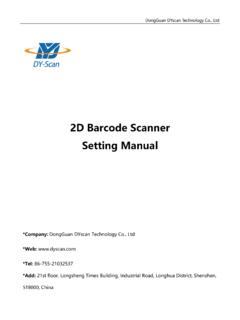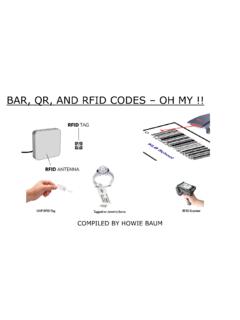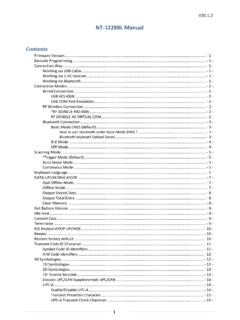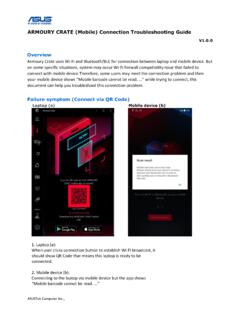Transcription of QR CODES IN EDUCATION AND COMMUNICATION
1 42 Turkish Online Journal of Distance EDUCATION -TOJDE April 2016 ISSN 1302-6488 Volume: 17 Number: 2 Article 4 QR CODES IN EDUCATION AND COMMUNICATION Dr. Gurhan DURAK Necatibey Faculty of EDUCATION Balikesir University, Balikesir, TURKEY E. Emre OZKESKIN Open EDUCATION Faculty Anadolu University, Eskisehir, TURKEY Dr. Murat ATAIZI COMMUNICATION Sciences Faculty Anadolu University, Eskisehir, TURKEY ABSTRACT Technological advances brought applications of innovations to EDUCATION . Conventional EDUCATION increasingly flourishes with new technologies accompanied by more learner active environments. In this continuum, there are learners preferring self-learning. Traditional learning materials yield attractive, motivating and technologically enhanced learning materials.
2 The QR ( quick response ) CODES are one of these innovations. The aim of this study is to redesign a lesson unit supported with QR CODES and to get the learner views about the redesigned material. For this purpose, the redesigned lesson unit was delivered to 15 learners in Bal kesir University in the academic year of 2013-2014. The learners were asked to study the material. The learners who had smart phones and Internet access were chosen for the study. To provide sectional diversity, three groups were created. The group learners were from Faculty of EDUCATION , Faculty of Science and Literature and Faculty of Engineering. After the semi-structured interviews were held, the learners were asked about their pre-knowledge about QR CODES , QR CODES contribution to learning, difficulties with using QR CODES about and design issues.
3 Descriptive data analysis was used in the study. The findings were interpreted on the basis of Theory of Diffusion of Innovations and Theory of Uses and Gratifications. After the research, the themes found were awareness of QR Code, types of QR CODES and applications, contributions to learning, and proliferation of QR CODES . Generally, the learners participating in the study reported that they were aware of QR CODES ; that they could use the QR CODES ; and that using QR CODES in EDUCATION was useful. They also expressed that such features as visual elements, attractiveness and direct routing had positive impact on learning. In addition, they generally mentioned that they did not have any difficulty using QR CODES ; that they liked the design; and that the content should include both superficial and in-depth information.
4 Keywords: Mobile learning, QR Code, COMMUNICATION , Distance EDUCATION INTRODUCTION It is possible to say that wider use of the Internet and the decrease in the prices of mobile devices has increased the use of these devices. People can work without any restriction of place and make use of these devices for different purposes. According to Al-Khalifa (2011), one of the most important aspects of mobile phones is their ability to access the Internet anywhere, which makes it possible to reach the information at any time they need. Mobile, namely ubiquitous learning is reshaping the learning environment. From SMSs to Smart Phones, it has changed the way of interaction 43 between learners and the learning materials.
5 Learners can reach learning objects (video, text, sound etc.) faster than ever before. Since correspondence learning, hard copy materials (course books) are the base materials of learning for open and distance learning courses at Anadolu University ( Acikogretim Sistemi - Tarihcesi, 2012). According to ABI research (2013), there were billion smart phones in the World. A raport about the use of smart phones, which was published in 2014, shows that the number had reached to billion (eMarketer, 2014). Another study revealed that 89% of the smart phones are used all day (Smartphone users around the World, 2012). Figure 1 presents the reasons for use of smart phones in the second half of 2011 around the World.
6 According to the data presented in the Table, smart phone owners use their phones for gaming, which is followed by social networks, music and news. Using smart phones for educational purposes is about 11%. Figure 1: Uses of Smart Phones Figure 2 presents the monthly data use for 2013 and 2014. According to the data, there was an increase of 69% in a year. Figure 3 shows the total Internet traffic data in 2000 and mobile Internet traffic data in 2014. According to Figure 3, mobile traffic data in 2014 were thirty times more than the total Internet traffic data in 2000. 6456443934262011gamesmusicentertainmentc ommunicationUses of Smart Phones 44 Figure: 1 2015 2019 Mobile data traffic by application TB by month (Cisco, 2015) When the graph in Figure 4 is examined, it is seen that two-third of the mobile data traffic will be of videos.
7 THEORETICAL BACKGROUND This study is grounded upon the Theory of Diffusion of Innovations and Theory of Uses and Gratifications. The data in this study were interpreted on the basis of these theories. Theory of Diffusion of Innovations The Theory of Diffusion of Innovations put forward by Rogers is based on four factors: innovation COMMUNICATION channel, time and social system. According to Rogers (2003), this diffusion is a process of COMMUNICATION via certain channels between the members of the social system regarding the new . In his theory, Rogers defined innovation as an idea, an application or an object considered to be new by an individual or organization. An innovation does not have to be a concept or a design that is definitely unknown.
8 It is enough that the individual or organization has not used it before (Berger, 2005). There are five phases in Roger s model: Knowledge, persuasion, decision, implementation and confirmation. Knowledge: The individual gets informed about the innovation and its use. Persuasion: The individual evaluates the positive and negative aspects of the innovation and shapes his/her attitudes accordingly. Decision: In this phase, the individual decides to accept or reject the innovation. Implementation: This phase exists if the decision phase is completed positively. Confirmation: The Individual affirms and strengthens the adoption decision (Orr, 2003). StreamingFile Sharing 45 Figure: 2 The innovation-decision process (Rogers, 1995) Theory of Uses and Gratifications The theory of Uses and Gratifications was first announced by Elihu Kats.
9 According to Katz, research on COMMUNICATION always focused on the question of What does media do for people? but the real question should actually be What people do with media? (McQuail & Windahl, 2010, ). Figure: 3 The Uses and Gratifications approach (McQuail & Windahl, 2010, ) In many studies based on the theory of Uses and Gratifications, gratifications obtained were perceived as motivations necessary for certain internet activities. Studies in related literature demonstrated that gratifications mostly included searching for information, entertainment, surveillance, COMMUNICATION between individuals, identity, acquiring status and gains (Charney and Greenberg, 2001; LaRose, Mastro and Eastin, 2001; Papacharissi and Rubin, 2000).
10 QR CODES QR CODES consist of black modules arranged in a square pattern on a white background. They are designed to decode the data quickly. It is quite easy to create and use these CODES (Pons, 2011). Using QR CODES for EDUCATION is another way of using the Internet. quick response (QR) CODES are versatile. A piece of long multilingual text, a linked URL, an automated SMS KnowledgePersuasionDecisionImplementatio nConfirmationThere are social and psychological origins of needs, which generate expectations of the mass media or other sources, which lead to differential patterns of media exposure resulting in need gratificatioonand other (often unintended consequencesACCEPT REJECT 46 message, a business card or almost any information can be embedded into the two-dimensional barcode.)
















